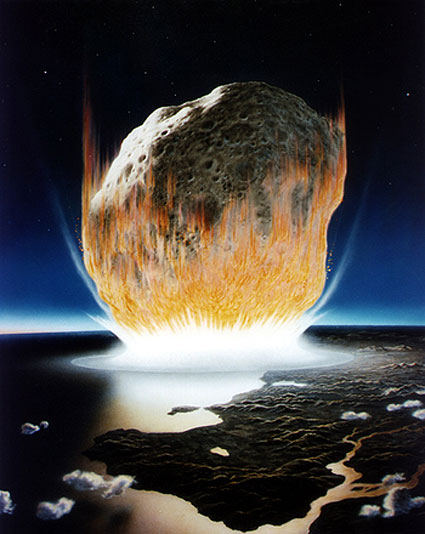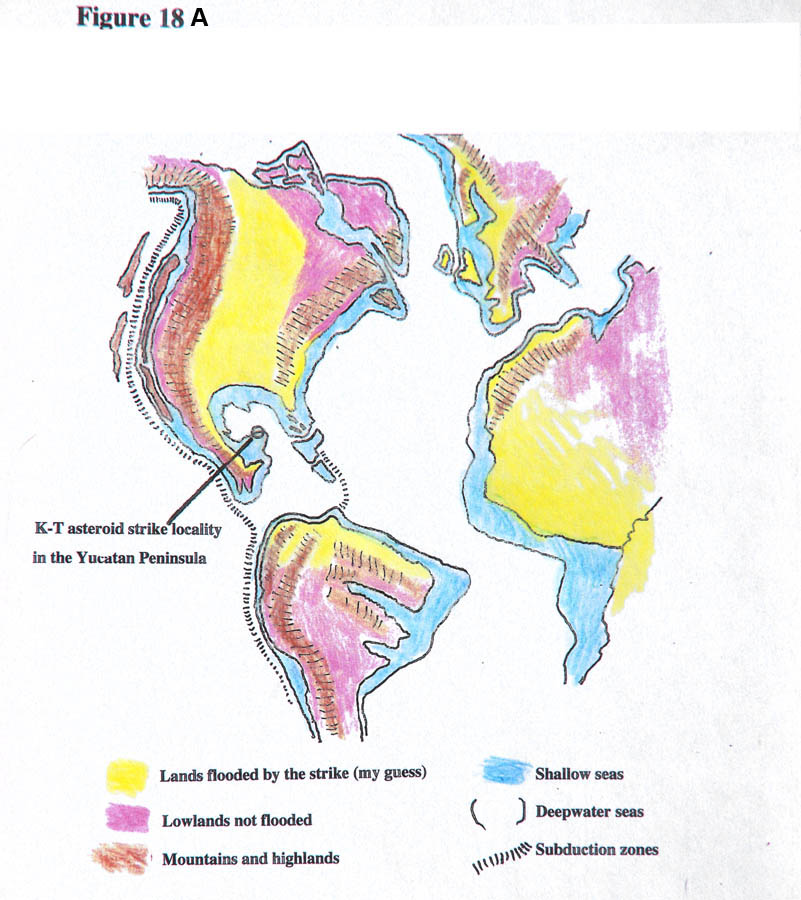Figure 18 is a dramatic view of that fateful day, the very last day of the Cretaceous period, the day we got hit hard. There are a few places in our region where you can see the boundary ash bed - the ash rain from the comet strike. The impact instantaneously melted a 10-mile-wide mass of crustal rock, so as seawater fell into the sizable crater it vaporized and a huge plume of steam and molten rock dust blew into the atmosphere, just like an oversized papa volcano. Go to Raton New Mexico (on I-25 just south of the Colorado border) and find the small mesa at the very edge of town on the west side. The road climbs to the top, where you can find a roadcut with a sign, and the inch-thick ash layer is pretty clearly seen. Think of one inch of ash raining onto the entire planet. Or you may travel north to Trinidad Colorado for another view of the ash bed. Find a good map. Take highway 12 westward from town about 6-7 miles and just past Trinidad Lake, find the road labeled '18.3 road', travel back SE along the southern lakeshore about a mile and watch for a big sign and kiosk. On the banks of a streamcut you can see the ash bed. Afterwards you can complete the highway 12 loop road by going around East and West Spanish Peaks, then returning to I-25. These are mid-Cenozoic granite-volcanic mountains. You can also see the level of the ash bed in Utah. From the main tourist highway 89, and 6-8 miles south of Panguitch, take highway 12 eastward and begin the climb towards Bryce Canyon National Park. Near the Red Canyon visitor center in about 4 miles (U.S. Forest Service), buried in the forested hillslopes is the K-T ash bed, though it is hard to find in good exposure (K = Cretaceous; T = Tertiary or Cenozoic). There are famous locations elsewhere, one on coastal Denmark is much studied.
Still another feature associated with the Laramide Orogeny was that during Laramide time (75-50 m.y. ago) the entire western third of the continent was somehow shoved upward, to gain additional elevation above sea level that is still with us, perhaps 2,000 ft regionally. Something got shoved or inserted under the entire western part of the continent to make it more buoyant. We don't know what happened, we only see the resulting higher elevations. And why were the granites formed at the time so enriched with copper, like none before or since?
Laramide-age granites are widespread in Arizona. The most popular showcase of this rock is at the popular rest stop on I-10 east of Benson at the place called Texas Canyon, on the top of the rise of the Dragoon and Little Dragoon Mts. Away from the visitor paths one may pick up very well-formed potassium feldspar crystals (called orthoclase) up to an inch long, formed in the orthorhombic crystal system. 70% of granite is feldspar. The rounded-boulder weathering pattern of the granite is obvious here. Original square-shaped granite masses are split by fractures in three directions, then slowly turn into round masses as they are exposed to the surface, just like the perfect ice cube in your drink slowly dissolves into a sphere. Then exposed boulders receive a mysterious 'case-hardening' layer that preserves their shape, while the granite rock underground decomposes quickly with soil moisture, turning into the coarse granular material called 'grus.' If you take the Dragoon exit off I-10 (just west of the rest stop) and then turn NORTH, there is a parking area near the freeway from where you can wander the amazing boulder field until your heart is content. Watch for rattlesnakes. A world-class example of case-hardened boulders is found at Cataveña, Baja California, where the boulders are actually totally hollow.
Many granites are shot through by pegmatite dikes, which are sheets of hard and resistant rock composed of feldspar and quartz with accessory minerals. A good view of such pegmatite dikes is atop Mt. Lemmon - take the ski valley road off the main road just before the road drops into Summerhaven, and just at the very first turn near the intersection are many obvious pegmatite dikes. The country rock here that they intrude is called the Leatherwood diorite, a relative of granite with more dark minerals. In the northern Catalinas this granite brought up considerable valued ore minerals of copper, silver, gold and tungsten. One mine was owned for a time by Buffalo Bill Cody who even shipped tungsten concentrate to Thomas Edison for manufacture of tungsten filament light bulbs.

